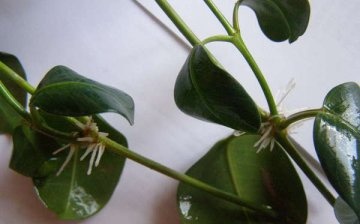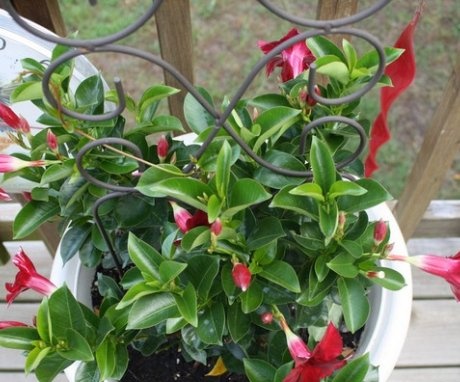Mandeville: proper flower care at home
Mandeville is an evergreen shrub of the Kutrov family. His homeland is South America. At home, Mandeville is grown in the form of a vine or bush.
Content:
- Description and types of plants
- Reproduction of Mandeville
- Growing and care
- Transplant and pruning
- Pests and diseases
Description and types of plants
Mandevilla stems at home can reach 3 m. Leaves are ovoid with a pointed end, smooth and shiny, from 3 to 9 cm long. They are located on long smooth stems, vines.
Especially beautiful are the flowers of a funnel-shaped or tubular plant with five pointed petals, tightly adjacent to each other at the base. The color of the petals is red, pink, yellow, white. The outer part of the tube is light. The diameter of the flower is from 7 to 10 cm. The stamens have paired nectaries. For this plant received a second name - diplomas.
The nectaries emit a delicate, pleasant aroma that attracts insects.
Flowers begin to bloom in early spring and last for 10 days. The bush pleases with flowering until November. Mandeville's milky juice is dangerous to human health. Therefore, all operations with it must be carried out with household gloves.
Common types of Mandeville:
- Bolivian is an evergreen plant. Curly shoots, covered with smooth leaves. They are sharper than other species. The flowers are funnel-shaped, white, with a yellow center. The petals are twisted in the form of a mill. The diameter of the flower is up to 5 cm. When the temperature drops, it drops the leaves. Another name for the plant is "Bolivian jasmine". It tolerates low temperatures well (about 12 degrees).
- Excellent - liana with red tubular flowers 4 cm in size, collected in clusters of 6-7 pieces. The size of one flower reaches 8 cm, the length of the tube is 5 cm.
- Sandera with oval leaves 5 cm long. Bright pink flowers with a yellow center are collected in a cluster of 3 to 5 flowers. Their size reaches 7 cm. It blooms from May to October. The most beautiful varieties of this species are Rubinina, Super trouper Double Pink with double pink flowers. Plants of this species do not like direct sunlight. Hibernates at a temperature of 18 degrees.
- Shiny is an evergreen shrub. The leaves are large, up to 20 cm long. White flowers are large, 10 cm in diameter, collected in a brush.
- Loose (Chilean jasmine or Brazilian balsam) is a deciduous vine with branches reaching 5 m. Flowers are large, up to 10 cm in diameter, cream-colored. They are collected in brushes of 5-15 pieces. Corrugated flower petals.
Reproduction of Mandeville
Mandeville is propagated at home by cuttings, each of which has two pairs of leaves. In the spring they use green, in the summer they are partially lignified. The length of each of them is about 10 cm.
Features of cuttings:
- Prepare a mixture of crushed peat sphagnum moss, sand.
- The prepared cuttings are treated with a root former.
- Placed in a dish filled with a substrate, dipping in the leaves
- Cover with bottles or film.
- Rooted at a temperature of 25 ° C for about a month and a half.
- Maintain high humidity by watering as needed. Ventilate so that fungi do not grow in the soil
The fact that rooting was successful is evidenced by the growth of shoots.The shelter is removed, and after another month and a half, young plants are transplanted into new dishes. They will be able to bloom next year. Some gardeners root cuttings in a glass of water. When the roots have grown 1 cm, they can be planted in pots.
Dipladenia with double flowers reproduce poorly by cuttings. Therefore, it is grown from seeds and whiskers. Seeds at home are formed and ripen infrequently. But they can be bought at flower shops. Prepare a light, loose, slightly acidic soil. The sown seeds are kept at temperatures up to 28 degrees. They germinate up to four months. All this time, the soil must be moistened without flooding. Mandeville can be propagated by tendrils that grow on the tips of the shoots. They are bent to the ground and fixed. Roots are formed at the point of contact. After that, the young plant is cut off and transplanted into a separate bowl.
Growing and care
Mandeville is grown in nutritious soil. It includes leafy, clay-soddy soil (2 parts), humus and sand. Be sure to lay a layer of drainage with a height of at least 3 cm.
How to properly care for a indoor flower:
- For active growth and flowering, Mandeville needs a lot of sunlight. It grows well on southern windows, but in the hottest periods it is better to shade it so that burns do not form on the leaves. In shade or partial shade, the plant will not bloom at all or will form few flowers.
- The temperature in an ordinary apartment (19-23 ° C) is well suited for growing Mandeville in spring and summer. Although the optimal temperature is 25 ° C. In winter, it is desirable to provide the plant with a dormant period, lowering it to 15-18 ° C. Loose needs a lower temperature, up to 5-10 ° C.
- In the summer, it is advisable to take the Mandeville outdoors. It blooms better there. Do not allow the plant to be exposed to wind or rain.
- Mandeville is very afraid of drafts in the apartment. Being near cold windows that let air into the room in winter can die. Therefore, the flower pot is hidden in a wooden box or sheathed with foam.
- To make the plant look beautiful, at the beginning of development, support for the shoots is installed in the pot and twisted in the right direction. Can be grown in pots attached to the wall. Then the shoots of the Mandeville, covered with flowers, will be directed downward.
- Like any tropical plant, Mandeville does not tolerate dry air. To ensure a moisture content of 70%, you need to spray the plant with a spray bottle every day. This is especially important in winter when grown near heating radiators. Pallets or other wide containers filled with water can be installed near the pots.
- Watering plants in summer and winter is significantly different. In the warm season, a diplopia needs a lot of moisture. The soil is moistened as the top layer dries up with soft water. Therefore, in hot weather, you have to water every day. Using tap water, it is defended for about a day. The water temperature should be equal to the temperature of the air surrounding the plant. Mandeville doesn't like cold or too warm water. Once every 5-6 waterings, a little citric acid is added to the water. In winter, the amount of watering is reduced and water is added only when it dries a few centimeters deep.
- Fertilization makes it possible to get a beautiful plant, abundantly covered with large bright flowers. From the beginning of spring to autumn, they are fed 2 times a month. It is enough to use mineral liquid fertilizers for flowering plants. In winter and late autumn, the plant is not fed. During this period, it is at rest.
Transplant and pruning
Young plants are replanted every year in early spring. When it becomes an adult, they change the pot only as needed. This is done when the roots begin to peek out of the drainage hole.
Young plants prefer peaty soils, and adults prefer turfy soils.
Under natural conditions, Mandeville flowers form only on young shoots growing from above. By trimming, you can ensure that they are evenly spaced throughout. It is carried out in early spring, before the flowers appear, or late in the fall, when they fade.
Young unbranched branches are cut, leaving a third of the length. Those on which there are branches are cut in the same way, but they start counting from the fork. In the spring, young shoots will grow from the remaining buds, on which flower buds will form. Autumn pruning of Mandeville is preferable. In this case, the plant will more easily endure the winter. Shoots will not suffer from dry air in the apartment.
Pests and diseases
Mandeville is almost unaffected by pests. More often they suffer from diseases of the root system. This is due to the fact that the plant is often watered. If water does not have time to be absorbed by the roots and pass into the drainage hole, the roots will rot. This is facilitated by nematodes and root mealybug, which are carried in with the soil. Therefore, before use, it must be calcined or disinfected in another way.
Root rot is a bacterial disease that affects a plant with improper watering and waterlogged soil.
Growing problems:
- The yellow and falling leaves of the mandeville indicate that the temperature in the room is violated.
- Sluggish and pale leaves indicate excessive dryness in the air.
- Weak and short flowering indicates insufficient room lighting.
- The flower grows slowly with a lack of minerals.
Mandeville is called indoor clematis. They really look like bright beautiful flowers and liana-shaped shoots.
More information can be found in the video:



















